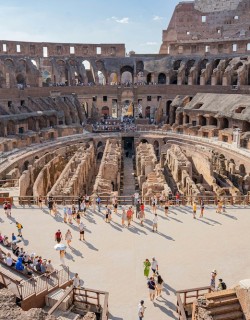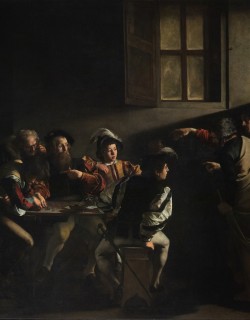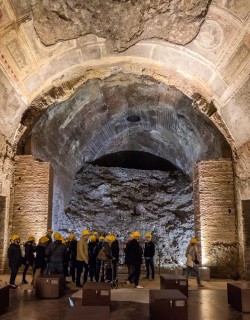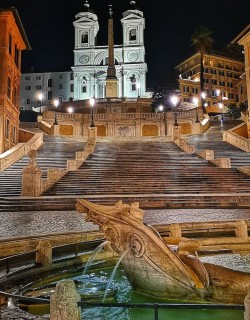Gian Lorenzo Bernini was not only one of the greatest artists and architects of the Baroque, but also one of the most prolific. It’s impossible to walk through the centre for Rome without stumbling across his work - the bee fountain on Via Veneto, a swooning St Teresa in Santa Maria della Vittoria, angels on Ponte Sant’Angelo, the elephant obelisk in front of Santa Maria della Sopra Minerva.
Bernini had a long and eventful career - a career which began, according to some accounts, at the tender age of 11 - and was working right up to his death in 1680, aged 81. Over the course of his career he transformed Rome, filling the city with marble saints and angels, and building some of the grandest fountains. And without Bernini, St Peter’s Square would look very different indeed.
Our Rome Tours are the perfect introduction to the works of Bernini; you’ll see his masterpieces not only in the churches and galleries, but also in the streets and piazzas. You’ll stand in front of his breathtaking Apollo and Daphne in the Borghese Gallery, and his monumental Fountain of the Four Rivers in Piazza Navona. Wikipedia has a comprehensive list of Bernini’s artworks, but if you’re in Rome and interested in seeing the works in person, here’s where to go.
The Vatican
Michelangelo may be the first artist you associate with the Vatican, but Bernini also made important contributions to the art and architecture of the basilica and piazza. In 1629 he was appointed head architect of St Peter’s, where he designed the imposing bronze baldachin that towers above the altar, as well as the theatrical funerary monument for the tomb of Pope Alexander VIII. St Peter’s Basilica is a highlight of all our in-depth Vatican Tours.
Many people walk through St Peter’s Square without realising that the design is essentially Bernini’s vision. The marble colonnades were designed to surround the visitor with “the maternal arms of Mother Church”, in the words of Bernini. The unusual trapezoidal shape of the piazza was mainly a result of space constraints, but Bernini cleverly made use of it to create a sense of awe. It’s Baroque theatricality at its most sublime.
Piazza Navona
The most striking feature of Piazza Navona is the Fountain of the Four Rivers, designed by Bernini for Pope Innocent X. Bernini’s admirably furbo (cunning) approach won the commission:
So strong was the sinister influence of the rivals of Bernini on the mind of Innocent that when he planned to set up in Piazza Navona the great obelisk brought to Rome by the Emperor Caracalla, which had been buried for a long time at Capo di Bove for the adornment of a magnificent fountain, the Pope had designs made by the leading architects of Rome without an order for one to Bernini. Prince Niccolo Ludovisi, whose wife was niece to the pope, persuaded Bernini to prepare a model, and arrange for it to be secretly installed in a room in the Palazzo Pamphili that the Pope had to pass. When the meal was finished, seeing such a noble creation, he stopped almost in ecstasy. Being prince of the keenest judgment and the loftiest ideas, after admiring it, said: "This is a trick … It will be necessary to employ Bernini in spite of those who do not wish it, for he who desires not to use Bernini’s designs, must take care not to see them.
Although it’s an undeniably impressive work of art, the fountain was initially met with opposition from angry locals. There was a famine in Rome, and protest signs read: “We do not want Obelisks and Fountains, It is bread that we want!”
Initial controversy aside, the fountain has become one of the most popular monuments in Rome, beloved by tourists and locals alike. The fountain features four gigantic statues representing the river gods, gathered around the base of an Egyptian obelisk.
Borghese Gallery
Many of Bernini’s greatest sculptures are on display at the Borghese Gallery, including his masterpiece Apollo and Daphne. This powerful statue is one of the highlights of our, Borghese Gallery Tour and it takes more than a glance to absorb its full impact. It’s only when you slowly walk around the statue that you realise the extent of Bernini’s genius. Apollo and Daphne depicts the key moment in the myth - when the nymph Daphne, who’s struggling to escape from Apollo, begins to transform into a tree. This surreal scene is hard to capture, as it requires a sense of energy and movement, but Bernini somehow uses heavy marble to convey a moment of swift transformation. The attention to detail is also impressive - look at Daphne’s fingers, turning into branches, or the curls of Apollo’s hair.
Other works by Bernini in the Borghese Gallery include the Rape of Proserpina, Aeneas, and an emotive David which provides an interesting contrast with the more famous Michelangelo statue.
Santa Maria della Vittoria
This church on Via XX Settembre may look like nothing special from the outside, but if you enter and visit the chapel on the left, you’ll see one of Bernini’s most startlingly dramatic sculptures. St Teresa swoons in ecstasy while a smiling angel prepares to pierce her with a golden arrow. It’s a depiction of the saint’s divine encounter:
I saw in his hand a long spear of gold, and at the iron's point there seemed to be a little fire. He appeared to me to be thrusting it at times into my heart, and to pierce my very entrails; when he drew it out, he seemed to draw them out also, and to leave me all on fire with a great love of God. The pain was so great, that it made me moan; and yet so surpassing was the sweetness of this excessive pain, that I could not wish to be rid of it.
Bernini brilliantly captures this ambiguous combination of pain and pleasure, as St Teresa reclines on a marble cloud of swirling fabrics, head titled back in rapture. “If that’s divine love,” said one cynical Frenchman, “I know all about it.”
Santa Maria Sopra Minerva
Before you enter this church near the Pantheon, have a look at the unusual obelisk in the piazza. The small Egyptian obelisk sits on the back of a marble elephant, which was designed by Bernini and sculpted by his assistant. It’s one of the quirkiest monuments in Rome, inspired by a stone elephant that appears in the 15th century novel Hypnerotomachia Poliphili, and intended to symbolise fortitude. Bernini’s plans were challenged by a rival architect, the Dominican priest Domenico Paglia, and the elephant’s position may not be coincidental, as its bottom points in the direction of the Dominican monastery.
Inside Santa Maria Sopra Minerva - the only church in Rome retaining its original Gothic features - are a few other works by Bernini, including a sculptural portrait for the tomb of Giovanni Vigevano. The most striking sculpture, however, is the memorial to Maria Raggi, a nun who performed miracles and died in 1600. Nearly fifty years, her family commissioned this monument - a warped curtain of marble slightly reminiscent of Salvador Dali’s melting clocks. The monument is an example of Bernini’s originality, and his ability to exploit the dramatic potential of every.



